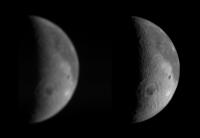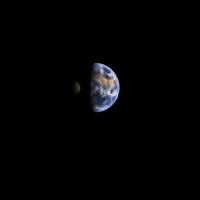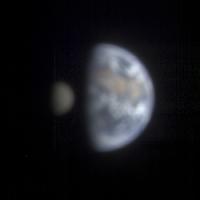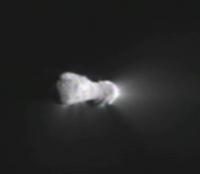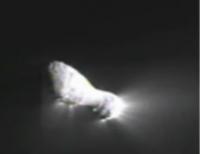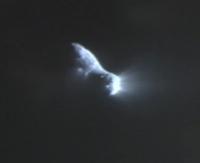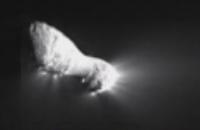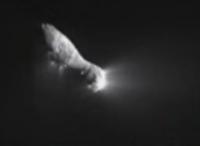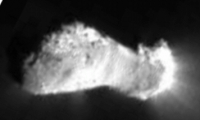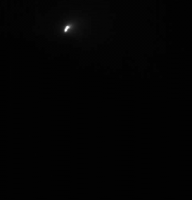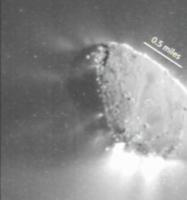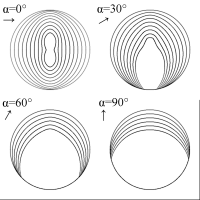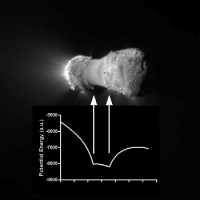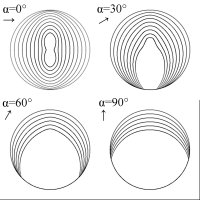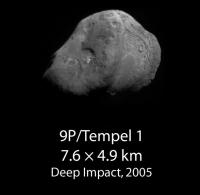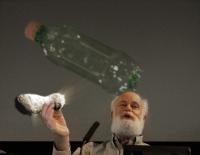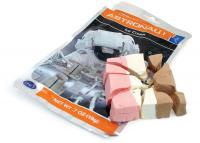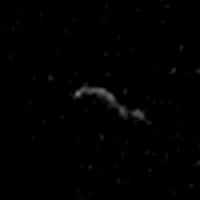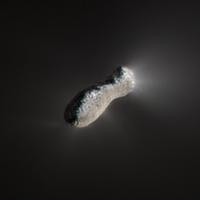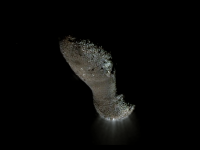Printable Version of Topic
Click here to view this topic in its original format
Unmanned Spaceflight.com _ Cometary and Asteroid Missions _ EPOXI Mission News
Posted by: stevesliva May 28 2008, 07:48 PM
Looks like the Deep Impact list has been revived. Posting here for others to get back on board:
**********************************************************************
EPOXI E-News #1 May 2008
**********************************************************************
WELCOME BACK!
Did you know that the Deep Impact Flyby Spacecraft has a new assignment? The
EPOXI mission combines two exciting science investigations in an entirely
new mission that re-uses the Deep Impact spacecraft. The Extrasolar Planet
Observation and Characterization (EPOCh) investigation will observe stars
that have known transiting giant planets. The Deep Impact Extended
Investigation (DIXI) of comets observes comet 103P/Hartley 2 during a close
flyby in October 2010.
The education and public outreach team decided to get back in touch with our
Deep Impact friends and begin sending out newsletters again to keep you
informed of these two exciting investigations! During the two years since
our last newsletter for Deep Impact, the science team has stayed busy
continuing to do more analysis on the data collected in July 2005. The
science team also proposed and was awarded an extended mission teaming up
with a group from Goddard Space Flight Center.
EPOXI website: http://epoxi.umd.edu/
Mission Overview: http://epoxi.umd.edu/1mission/index.shtml
Press Releases: http://epoxi.umd.edu/7press/index.shtml
DI Results: http://deepimpact.umd.edu/results/
**********************************************************************
MISSION STATUS
Dr. Deming, Principal Investigator (PI) for the EPOCh portion of the
mission, sends us the latest mission status report in which he tells us
about the current observing target GJ436. “This is an exciting time for
EPOCh, as we search for an exo-Earth orbiting a stellar neighbor of our
Sun!” reports Dr Deming. He also talks about the plans to observe a very
special planet in late May and early June.
Read his status report as well as past reports from other team members at
http://epoxi.umd.edu/1mission/status.shtml
**********************************************************************
EPOCh TARGETS
The EPOCh component of the EPOXI mission will carefully study a small number
of stars in order to learn more about planets that we know are orbiting
those stars by watching the planets as they transit (cross in front of) the
star. EPOCh will also search for clues to other planets that might be
orbiting the same stars.
Read more about the EPOCh science targets to find out which stars are being
observed.
http://epoxi.umd.edu/2science/targets.shtml
**********************************************************************
PLANET QUEST
Are we alone?
For centuries, human beings have pondered this question. Medieval scholars
speculated that other worlds must exist and that some would harbor other
forms of life. In our time, advances in science and technology have brought
us to the threshold of finding an answer to this timeless question.
The recent discovery of numerous planets around stars other than the sun
confirms that our solar system is not unique. Indeed, these "exoplanets"
appear to be common in our galactic neighborhood.
The EPOCh investigation is part of a larger family of missions studying
extrasolar planets. Learn more at the Jet Propulsion Lab Planet Quest Web site.
http://planetquest.jpl.nasa.gov/index.cfm
**********************************************************************
OBSERVING CHALLENGE
The transits that will be studied for EPOCh are extremely difficult to
observe because the change in brightness is very small and requires high
precision photometry that can be accomplished with instruments on the Deep
Impact spacecraft. Observers on Earth can still take a look at the stars in
the night time sky. The selected stars are also pretty dim because we don’t
want them to saturate or over expose the spacecraft instruments but they are
bright enough to be visible in amateur telescopes if the sky conditions are
good and the skies are dark.
Like people, stars have multiple identifiers. EPOCh’s first target was a
star labeled as HAT-P-4 by the scientists observing it. They made their own
list of target stars so that was their shorthand name. But HAT-P-4 has
numerous other names which are more useful in identifying it in other databases.
HAT-P-4 = SAO 64638 = TYC 2569-1599-1 is a magnitude 11, G-class star
located in the constellation Boötes.
Chart: http://epoxi.umd.edu/2science/challenge.shtml
**********************************************************************
SUBSCRIPTION INFORMATION
Please forward this e-mail to others interested in NASA missions. New
subscribers may join the EPOXI Mission e-news mailing list on our website
at: http://epoxi.umd.edu/6outreach/newsletter.shtml
Posted by: mps Jun 3 2008, 07:31 PM
http://epoxi.umd.edu/4gallery/Earth-Moon.shtml
Posted by: tedstryk Jun 4 2008, 12:37 AM
Wow, it got a beautiful shot. I can't wait for the raw data release.
Posted by: CAP-Team Jun 4 2008, 10:48 AM
Here's a simulated view:
Posted by: tedstryk Jul 4 2008, 04:40 PM
I still can't wait for the raw data. There really is a lot of data in the images. For example, here is a cleanup of a view of the moon from shortly after launch.
Posted by: tedstryk Jul 4 2008, 06:43 PM
Here is the earth moon shot using the same technique I used on the lunar shot.
Posted by: Paolo Jul 19 2008, 07:50 AM
Two papers about EPOXI published yesterday by arxiv:
http://arxiv.org/abs/0807.2852
http://arxiv.org/abs/0807.2803
Posted by: Rich Mar 19 2009, 08:46 PM
As a member of the EPOXI flight team, I am astonished that this data has been made public yet. The EPOCh portion of EPOXI finished 8/31/08 (photometry of transiting hot-jupiters and observing Earth as an exo-planet analog). The science team has had over 7 months to analyze the data and the only thing made public is the lunar transit animation. Granted, that's pretty sweet, but you'd think they would release some more data.
I met Doug (UMSF founder) on Tuesday (3/17) when he was here at JPL. I'm impressed with what you all are doing on the site with MER data, among the other missions. I'd love to see UMSF participate real-time with the Hartley-2 flyby similar to the DI prime mission flyby of Tempel-1.
Let me talk with our Public Outreach people and our science team and I'll see if I can get any data released to the "world". What exactly would you guys want? .jpgs? raw binary images? Please let me know and I'll see if I can get any data released.
Many thanks and keep up the great work! I always like to see people excited about EPOXI when most people at JPL don't even know we exist!
~Rich
p.s. we just published a paper on how we did the EPOCh observations at the 2009 IEEE Aerospace Conference. I'm not sure if the paper is available to the public free-of-charge, but I'll see if I can get a copy of the paper and presentation out...
Posted by: ugordan Mar 19 2009, 08:50 PM
I'm waiting for the lunar transit images myself. I read the archival plan document which stated EPOCh data was supposed to be delivered to PDS back in October so I was expecting the peer review and release to come in January. It's now March and still no luck. Is there perhaps a delivery planned for April or is it postponed indefinitely?
Posted by: Stu Mar 19 2009, 08:55 PM
Welcome aboard Rich, good to have you here! ![]() Anything you can drop into our eager little hands will be greatly appreciated!
Anything you can drop into our eager little hands will be greatly appreciated!
Posted by: elakdawalla Mar 19 2009, 10:12 PM
Of course image processing mavens dislike JPEGs because of the compression artifacts, but raw binaries are inaccessible except to a few people with the technical knowledge necessary to open them. A good compromise is PNG, which most browsers display just as easily as JPEG (so it's accessible to the less-skilled) but which don't suffer from compression artifacts. (PNGs can also be 16-bit, while JPEGs max out at 8 bits per channel. I haven't looked into the DI camera system lately so I don't recall what bit depth it's capable of and don't know whether that matters.) On top of that, metadata for each image is valuable, starting with the simplest stuff like date/time of the observation, target, and filter choices. Some of the more skilled people here will gladly ingest whatever metadata you can get away with releasing -- either as detached headers for each image, or just one text file containing the data for all the images, like you get with the PDS INDEX.TAB files, will make people here jump for joy.
--Emily
Posted by: dmuller Mar 20 2009, 12:35 AM
Hello Rich, welcome to UMSF. I am running realtime simulations for current interplanetary spacemissions, including http://www.dmuller.net/epoxi, so I am greatly interested in up-to-date SPICE kernels to extract trajectory data (spk_od224_NoBurn-full.bsp is the current file, right?) and/or in up-to-date Horizons data (which seems to be there). I also include a mission timeline, so I am very keen on any mission events (TCM's, particular observations, etc) that I can include in the timeline, preferably in advance of them happening.
I have noted that EPOXI is not on the Solar System Simulator (http://space.jpl.nasa.gov/) ... Deep Impact is but gives an error if you enter today's date ... which I think would be a good tool to have (both for the general public and to incorporate images into my simulations). So maybe you could suggest to the team at the Solar System Simulator to have EPOXI enabled :-)
Good luck with your mission!
Posted by: Rich Mar 23 2009, 05:11 PM
Daniel, the SPICE kernel you have is slightly out of date. Your version was generated before TCM-14 without the TCM-14 burn. You want to be using spk_drm224_Burn-full.bin That's the latest and greatest o.d. solution. Where are you getting these by the way? Are they public?
I sent an e-mail to the webmaster for space.jpl.nasa.gov and asked him to add EPOXI. He hasn't gotten back to me, but I hope we'll get EPOXI in there.
I talked to the P.I. about getting EPOCh images released to the public. They're thought is, "why should we release them is no one will want to look at them because they're ugly, fuzzy images, especially in .jpg format." The data should be published to the PDS next month and made public about a month after. So, images around May perhaps... don't hold your breath.
Oh, and we're going to do another Earth observation of the North pole on Friday 3/27/09. It should give us some more pretty pictures ![]()
~Rich
Posted by: Paolo Mar 23 2009, 06:49 PM
I would definitely be interested in seeing it!
Posted by: Rich Mar 23 2009, 08:27 PM
I called the ethics office on Thursday. I don't know the legalities of posting it here. I think I can get the presentation here, but I'm not sure about the paper. I'll get them up as soon as I know if it's legal. The paper is entitled "The Contingency of Success: Deep Impact's Planet Hunt" published at the 2009 IEEE Aerospace Conference in Big Sky, MT if you want to search for it. If you find a url to it, be sure to post it here.
~Rich
Posted by: Rich Mar 23 2009, 09:52 PM
So I just got a blessing from the Ethics office. Attached is the presentation on EPOCh observations I gave at the IEEE conference in Big Sky. Feel free to bug me with questions. I'm continuing to research the legal aspects of posting the paper here too. Stay tuned! EPOCh_IEEE_Presentation_umsf.pdf ( 963.67K )
: 930
EPOCh_IEEE_Presentation_umsf.pdf ( 963.67K )
: 930
~Rich
Posted by: dmuller Mar 24 2009, 12:35 AM
Dear Rich,
Thanks so much for the clarification. I will incorporate the file into the next data update.
Yes the SPICE kernels are public and for most missions they can be found at http://naif.jpl.nasa.gov/naif/
EPOXI, still under the Deep Impact name, is listed under the Comet and Asteroid missions at http://naif.jpl.nasa.gov/naif/data_comet.html
The Horizons system at http://ssd.jpl.nasa.gov/?horizons also runs on SPICE kernels but occasionally it is not updated. At the moment it seems to use
----------------------------- -------------------- --------------------
[...]
drm220_withTCM12-full 2008 APR 18 09:00:00 2008 DEC 09 00:00:00
(103P/Hartley 2 soln.: #49)
drm223_with_tcms-full 2008 DEC 09 00:00:00 2012 JAN 31 00:00:00
epoxi_2008-2019.090217 2012 JAN 31 00:00:00 2019 JAN 01 00:00:00
Thanks.
If you wish to include timeline events, feel free to send them to me and I'll upload them in due course. Anything to create a grain of outreach for your mission :-)
Posted by: Bjorn Jonsson Mar 25 2009, 12:03 AM
I myself prefer PDS formatted data and there are probably lots of people here that also prefer it but PNGs are better known and are probably the best option to make the data easier to use for lots of people. As previously discussed, PNGs are far better than JPGs due to the absence of compression artifacts and the fact that they can be 16 bits/pixel when needed. Their only drawback compared to JPGs is bigger files.
Posted by: Rich Mar 25 2009, 08:43 PM
Sorry Bjorn. I don't think the project will release any EPOXI data to the PDS until April and it may not get released to the public until May. You'll have to stay perched on the edge of your computer chair until then. I'll see if I can get anything released to the world, but you may have to settle for .jpgs. Sorry! .jpgs are better than nothing!
~Rich
Posted by: Rich Mar 27 2009, 12:15 AM
Mission update:
FYI, we will be taking more pictures of the Earth tomorrow in a similar fashion to how the previous Earth observations were performed (in fact, we're using the exact same sequences, fancy that). However, we will be significantly closer than the Earth Observation that took the lunar transit movie (17 Gm compared to 50 Gm (that's giga-meters, or Mkm (that's Mega-kilometers) (and yes, that's a subnested parenthetic remark)). Since the spacecraft is now north of the ecliptic plane, we will be looking down on the Earth's north pole. A simulated image of what we might see has been floating around JPL. I'll ask around to see if I can post it.
Images will be coming down Saturday.
~Rich
Posted by: elakdawalla Mar 27 2009, 12:49 AM
Sweet. Can't wait to see the pics. --Emily
Posted by: Rich Mar 30 2009, 10:21 PM
Good luck with your mission!
dmueller: It's amazing what a simple e-mail does
In other news, the images from this weekend's Earth Observation are now on the ground and they look great!
Posted by: dmuller Mar 31 2009, 02:51 AM
Thanks for asking, Rich! Have updated the http://www.dmuller.net/epoxi accordingly.
Incidentally I figured out how to make my website tweet to my Twitter. In due course I hope to get it to periodically tweet mission updates onto my Twitter. Standby.
Posted by: Rich Mar 31 2009, 11:27 PM
Hi all,
I just noticed a new article on the EPOXI website by the EPOCh P.I. Drake Deming:
http://epoxi.umd.edu/2science/alienmaps.shtml
Enjoy!
~Rich
Posted by: Paolo Apr 1 2009, 07:40 PM
There was a presentation on the same subject here: http://www.astro.washington.edu/users/cowan/archives/research/EPOXI_lunch_talk.ppt but it has been removed. It is cached on Google in html
http://209.85.129.132/search?q=cache:wdXK3H-SEJ8J:www.astro.washington.edu/users/cowan/archives/research/EPOXI_lunch_talk.ppt
Posted by: dmuller Apr 4 2009, 06:55 AM
Selected trajectory information about some missions (including EPOXI) are now tweeting automatically to my http://www.twitter.com/dmuller about once every day
Posted by: Rich Apr 7 2009, 04:44 PM
http://209.85.129.132/search?q=cache:wdXK3H-SEJ8J:www.astro.washington.edu/users/cowan/archives/research/EPOXI_lunch_talk.ppt
Paolo: I can't seem to find those presentations. You don't have a copy of them do you?
~Rich
Posted by: Paolo Apr 7 2009, 07:26 PM
~Rich
I don't. I only have saved the cached google copy
Posted by: tedstryk Apr 10 2009, 06:40 PM
FYI, Hubble is presently studying Hartley-2 to try to pin down the basic properties of the nucleus, especially the rotation period, so that the information can be incorporated into mission planning.
http://www.stsci.edu/cgi-bin/get-visit-status?id=11990&markupFormat=html
http://archive.stsci.edu/proposal_search.php?mission=hst&id=11990
Posted by: Paolo Apr 12 2009, 06:48 PM
Observations have also been carried out by Spitzer, but I have noy seen results published yet http://adsabs.harvard.edu/abs/2008sptz.prop50593L
Posted by: Paolo May 21 2009, 07:15 AM
A nice presentation http://www.stsci.edu/institute/itsd/information/streaming/archive/SpringSymposium2009/DrakeDaming050409Hi_supporting/Deming
Posted by: Paolo May 26 2009, 05:05 AM
I just noticed a new article on the EPOXI website by the EPOCh P.I. Drake Deming:
http://epoxi.umd.edu/2science/alienmaps.shtml
Enjoy!
~Rich
The article http://arxiv.org/abs/0905.3742 is now on arxiv
Posted by: Paolo Jun 7 2009, 06:40 AM
There is a mission update on the EPOXI site: http://epoxi.umd.edu/1mission/status.shtml
Characterizing Comet Hartley 2
Although the EPOXI mission's spacecraft is in a period of relative inactivity, the team is still actively working on a variety of questions. One of the key areas of investigation is the characterization of the next target, comet Hartley 2. Several investigations have been carried out to characterize the nuclear size and albedo, the large dust, and the rotation of the nucleus. These investigations have been aimed for the period before the nucleus begins outgassing significantly as it approaches the sun.
Observation were taken with the Spitzer Space Telescope in August 2008. The analysis of those data yields a nuclear effective radius of 0.6 km, slightly smaller than, but still comparable to, the size deduced using the European Infrared Space Observatory at the previous apparition. These observations also show that there is a trail of large dust particles released much earlier and still orbiting the sun close to the nucleus. This is a common phenomenon among comets.
The next step was an effort to determine the rotational period in order to design the observing sequence for the approach to the comet. A series of observations with the Hubble Space Telescope in late April were somewhat puzzling. Subsequent observations with a variety of ground-based telescopes, particularly with Gemini-South and Gemini-North on the same night, have suggested a rotational period near 2/3 day, but with narrow minima that were not caught in the HST observations.
Posted by: Paolo Jun 21 2009, 06:38 PM
From the latest Discovery and New Frontiers http://discoverynewfrontiers.nasa.gov/news/newsletters/newsletter_archive/2009/June2009.pdf
Although the EPOXI mission's spacecraft is in a period of relative inactivity, the team is actively working on a number of areas of interest, including characterizing the next target, comet Hartley 2.
Several investigations have been carried out to characterize the nuclear size and albedo, the large dust, and the rotation of the nucleus. These studies are timed for the period before the nucleus begins outgassing significantly as it approaches the sun. Another effort is to determine the Hartley 2’s rotational period to design the observing sequence for the approach to the comet. A series of observations with the Hubble Space Telescope in late April were somewhat puzzling. Subsequent observations with a variety of groundbased telescopes, particularly with Hawaii’s GeminiSouth and GeminiNorth on the same night, suggest a rotational period near 2/3 day, but with narrow minima that were not caught in the HST observations.
The team is preparing to continue its role in testing software that could lead to improved interplanetary network communications. Last fall, a NASAwide team used DisruptionTolerant Networking, or DTN, software to transmit dozens of space images to and from the Deep Impact spacecraft which was more than 20 million miles from Earth. The test was called DINET (Deep Impact DTN experiment). Computers on the ground at JPL were used to simulate stations on Earth, Mars, and the Martian moon Phobos. The experiment was successful, with all the data transmitted without corruption even as various faults and breakdowns in the system were simulated.
The team was pleased to support this activity that will ultimately lead to much better communications across the solar system. The Preliminary Design Review for DINET2 was conducted on May 13. The current timeline is being reviewed to determine when to begin DINET2 activities on the spacecraft. It may begin following the infrared imaging of Earth at high southern latitudes scheduled for August 17.
Posted by: Paolo Jun 26 2009, 05:07 AM
Published at last http://arxiv.org/abs/0906.4733
Posted by: dmuller Jun 30 2009, 06:24 PM
There was a somewhat distant Earth flyby of Epoxi on 29 June at some 1.3 million km ... distant yet Epoxi is still closer to Earth than Planck is at the moment. Next close-ish approach at the end of the year
Posted by: Paolo Aug 1 2009, 03:39 PM
http://epoxi.umd.edu/1mission/status.shtml#31Jul2009
Posted by: Paolo Aug 28 2009, 06:39 PM
Browsing the DSN schedule (http://rapweb.jpl.nasa.gov/Planning/TMODMISS.pdf) I noticed that EPOXI is to conclude in November 2010 after the Hartley flyby, but the document gives a "probable end" date for the mission of 31 October 2011. Any idea what they plan to use the spacecraft for during the intervening year?
Posted by: IM4 Aug 29 2009, 05:03 PM
EPOXI trajectory from HORIZONS lasts till February 1, 2012. My program predicts several distant flybys of tiny asteroids and pass through cloud of Schwassmann-Wachmann comets:
73P-BB/Schwassmann-Wachmann 0.15935 2011-May-30
73P-V/Schwassmann-Wachmann3 0.06787 2011-Jun-15
73P-BD/Schwassmann-Wachmann 0.06865 2011-Jun-21
73P-BG/Schwassmann-Wachmann 0.06644 2011-Jun-28
73P-BR/Schwassmann-Wachmann 0.07153 2011-Jul-02
73P-BF/Schwassmann-Wachmann 0.09753 2011-Jul-23
73P-AT/Schwassmann-Wachmann 0.11083 2011-Aug-27
I guess they could tweak spacecraft's trajectory and study some of these objects.
Posted by: Paolo Aug 31 2009, 05:47 AM
I wrote to EPOXI PI to ask for some clarifications and he tells me that
Posted by: Paolo Sep 17 2009, 05:09 AM
On ArXiv today http://arxiv.org/abs/0909.2875
Posted by: elakdawalla Sep 24 2009, 12:49 AM
I'm pretty sure the answer is "no" but I thought I'd check here...has there been a PDS release of any of the Deep Impact / EPOXI data from after the Tempel 1 encounter? Specifically, have any of the MRI or HRI images of Earth and/or Moon hit the PDS?
--Emily
Posted by: djellison Sep 24 2009, 06:02 AM
http://pdssbn.astro.umd.edu/missions/epoxi/index.html
Nothing.
Posted by: Rich Sep 25 2009, 08:50 AM
Hi all:
Just a quick update. EPOXI scientists have discovered water absorption features on the moon. The data was obtained from the IR spectrometer calibrations taken in December and twice in June. Chandryaan's M3 instrument also observed similar absorption features. This was published in Science yesterday. Read more here:
http://epoxi.umd.edu/2science/hydratedmoon.shtml
~Rich
Posted by: Paolo Dec 14 2009, 06:31 PM
Yet another EPOXI-related paper on arXiv:
http://arxiv.org/abs/0912.2132
Posted by: ugordan Dec 22 2009, 08:21 PM
Nothing.
*cough*
Gamma-corrected, 650 nm "orange" (actually red), 550 nm green and 450 nm blue filter HRIV composite with channel mix to bring the channels to sRGB spec.
Err... anyone know of any good image deconvolution software?
Posted by: elakdawalla Dec 22 2009, 09:52 PM
Egads. Merry Christmas from EPOCh! Thanks for the heads up, Gordan. I think I'll sit this one out and watch you wizards try to make something better of these data ![]()
Now if I could only remember why I was asking that question in the first place...
--Emily
Posted by: ugordan Dec 22 2009, 11:48 PM
23 frames from March 18, 2008, covering over 5.5 hours, again motion-interpolated in an http://www.fileden.com/files/2007/9/14/1431389/78.avi (1 meg). I believe there's material for a complete rotation as it goes on to March 19 so this is still a work in progress.
Posted by: Paolo Jan 18 2010, 07:34 PM
No one seems to have noticed this release yet
http://epoxi.umd.edu/7press/news/20100105.shtml
Posted by: ugordan Jan 18 2010, 07:39 PM
Ooh, neat! More, higher resolution movies of Earth! Can't wait for it to hit PDS in about a couple of years from now! ![]()
Posted by: scalbers Jan 18 2010, 07:44 PM
http://epoxi.umd.edu/7press/news/20100105.shtml
Interesting that they are implying it may be possible to see sun glints on extrasolar planets.
Posted by: Paolo Feb 28 2010, 09:06 AM
PDS RELEASES EPOXI (EPOCh) MISSION DATA
The NASA Planetary Data System is pleased to announce release of the data from EPOXI, Extrasolar Planet Observation and Characterization (EPOCh) stage of the mission. The delivery includes raw and calibrated images (exoplanet transits and Earth) and infrared spectra (Earth) acquired during 2008.
The data are available through the PDS Small Bodies Node. To see and download the data as well as mission and instruments information, go to:
http://pdssbn.astro.umd.edu/missions/epoxi/
Posted by: Paolo Mar 5 2010, 05:32 AM
After more than six months, the EPOXI mission site has some http://epoxi.umd.edu/1mission/status.shtml. Nothing particularly interesting anyway
The majority of the data from EPOCh have been made public both at the Small Bodies Node of NASA’s Planetary Data System (PDS-SBN) and at the Multi-Mission Archive at Space Telescope (MAST). A few datasets taken in 2009 and some derived data (such as the final light curves of transiting planets) still remain to be delivered.
There were two significant activities for DIXI in February. On February 16 we carried out the first of several cruise calibrations that are planned. The others will be in the summer, a few weeks prior to encounter, and a few weeks after encounter. These data ensure that we understand the operation of the instruments and can readily provide calibrated data after the encounter. The second significant activity in February was a face-to-face meeting of the science team with key members of the operations team to lay out the detailed sequence of observations to be made during the encounter (much like the Sequence Symphony from Deep Impact). These observations will include observations on approach starting 60 days prior to closest approach and observations on departure for 21 days. The details of these plans must be decided well in advance because it is necessary to test them extensively on simulators in order to be sure that everything operates as planned. Deep space flyby encounters such as this one do not allow any opportunity to redo any observations if something goes wrong and last minute changes are very risky. Thus these encounters are dealt with much more rigorously than are observations, e.g., with telescopes in orbit around Earth. For those observatories, it is essential to ensure the safety of the spacecraft and instruments but if the observation fails it can be repeated. We have no chance to repeat the observations. We will continue to change some details to the observing sequence over the next few months but the basic approach is completely determined at this time.
Posted by: Paolo Mar 13 2010, 11:40 AM
According to the two Facebook profiles related to the mission (EPOXI Mission and Deep Impact Flyby), AutoNav on the flyby probe, unused for years, is being checked next Tuesday.
Posted by: Paolo May 11 2010, 05:09 AM
today on arXiv: http://arxiv.org/abs/1005.1505
Posted by: dmuller Jun 24 2010, 07:33 AM
EPOXI is now 3.5 days from its final(?) Earth flyby. It's already closer to Earth than Herschel and Planck!
Posted by: elakdawalla Jul 1 2010, 06:58 PM
Update on the Earth flyby with a few notes about the November encounter with Hartley 2 posted on the Deep Impact website:
http://epoxi.umd.edu/1mission/status.shtml
Posted by: Paolo Aug 29 2010, 09:19 AM
There was http://arxiv.org/abs/1008.4556 on Hartley 2 this week on ArXiv.
In particular, it is predicted that H2's surface will not be too different from comets already visited by spacecraft. It seems to be loosing a significant percentage of its radius at each perihelion, and could be extinct in just a century.
The author also calls for a mission to a really old comet like Wilson-Harrington or a relatively old one like Encke. He predicts that they "will have a more extreme surface morphology, than the cometary surfaces that have been imaged up to now"
Posted by: Rich Sep 4 2010, 01:33 AM
Salutations UMSF members,
We just completed a point-spread function calibration of the HRI this morning in preparation for Encounter. We also uplinked and activated the sequences to take the first 20-days of approach images from E-60days to E-40days. The first images should clock out around 13:30 UTC Sunday 9/5 with the images hitting the ground at 14:23 UTC. There's talk of putting a few of these on the website, but 60-days out, it should be just a fuzzy blob a few pixels across.
Keep refreshing epoxi.umd.edu or the EPOXI facebook page for updates!
~Rich
Posted by: Stu Sep 4 2010, 06:03 AM
Thanks for the update, Rich, really looking forward to this encounter. ![]()
Posted by: Paolo Sep 8 2010, 05:37 PM
first Hartley 2 pictures from Deep Impact
http://epoxi.umd.edu/3gallery/Hartley2_first_light.shtml
Posted by: dmuller Sep 14 2010, 06:33 AM
Any Epoxians here? Would love to know which current SPICE kernel to use in my realtime simulation (http://www.dmuller.net/epoxi ... version 3 rolling out in due course):
spk_drm230_WithBurn-full.bsp
or
spk_od230_NoBurn-full.bsp
Thanks in advance!
Posted by: stevesliva Oct 5 2010, 09:39 PM
I've attempted to create an RSS feed for the "Daily Comet" at http://epoxi.umd.edu/6outreach/daily.shtml here:
http://feedity.com/rss.aspx/umd-edu/UVdbWlZV
(I'm sure someone is about to post an official one, but I couldn't find it, so I got to try out feedity.com's advanced features.)
Also, I'd suggest the moderators split this thread into a Comet Hartley Encounter thread beginning with the Sept. 3rd post.
Posted by: Paolo Oct 11 2010, 05:27 PM
after Deep Impact, after EPOXI, an encore...
In February 2011, the Deep Impact spacecraft will complete its mission
(renamed EPOXI) for a study of extrasolar planets during its cruise to
encounter Comet Hartley 2.
This Request for Information (RFI) solicits input from the broad space
science community that would contribute to NASA's study of possible
new uses for the NASA Deep Impact/EPOXI spacecraft beyond its current
mission and would support NASA's science objectives in any of SMD's
research disciplines (Astrophysics, Earth Science, Heliophysics, and
Planetary Science). Responses to this RFI will be used to inform
NASA's program planning.
The RFI is posted on the NASA research opportunity homepage at:
http://nspires.nasaprs.com/
(select "Solicitations" then "Open
Solicitations" then "NNH11ZDA003L").
The response date is November 5, 2010. For further information on
this RFI, please contact:
Mr. William Knopf
Science Mission Directorate
NASA Headquarters
wknopf@hq.nasa.gov
Posted by: djellison Oct 11 2010, 06:14 PM
I'd been wondering if they would try an XXM with it ![]()
Posted by: Paolo Oct 11 2010, 06:55 PM
Of course with the 4.15 kg of fuel remaining I doubt that they will manage to do anything more significant than EPOCh-like observations.
I tried to play a little bit with the orbital elements given in the RFI document, but it seems like the probe will not come back to the vicinity of Earth before 2018, so no gravity assist possible
Posted by: jmknapp Oct 12 2010, 07:39 PM
spk_drm230_WithBurn-full.bsp
or
spk_od230_NoBurn-full.bsp
Thanks in advance!
I'd be curious to know too. I just published a Hartley 2 app that runs on Android devices & used the spk_od230_NoBurn-full.bsp file. It seems that that's still the file with the most recent datestamp on the NAIF website.
Searching on "hartley" in the Android market will bring up the app.
Joe
Posted by: djellison Oct 12 2010, 08:07 PM
I get the loading screen, then it crashes out
DroidX on 2.2
Posted by: jmknapp Oct 12 2010, 10:29 PM
DroidX on 2.2
Thanks for checking it out--I just tried it on the 2.2 emulator & indeed it crashed. I just uploaded a new version to the market & would appreciate it if you give it another try.
Posted by: djellison Oct 12 2010, 10:44 PM
Yup - it works now
Posted by: jmknapp Oct 12 2010, 11:58 PM
Thanks for helping me test this--I only have a version 1.6 device (G1) & for later versions the emulator can only go so far, like it doesn't test the GPS features. I trust that your latitude and longitude were displayed correctly? If it can't read the geolocation, it defaults to Greenwich (0W, 51.67N).
Posted by: jmknapp Oct 21 2010, 11:23 AM
Managed to get a shot of Hartley 2 the other night:
http://i187.photobucket.com/albums/x269/jmknapp/103p_garden_det.jpg
Here's a little wider context:
http://i187.photobucket.com/albums/x269/jmknapp/103p_garden.jpg
That's a 60-second exposure with an Olympus E-510 DSLR, 1000mm refracting telescope as a telephoto lens.
Stellarium had this configuration:
http://i187.photobucket.com/albums/x269/jmknapp/103P_stellarium-1.png
By the time of the Deep Impact flyby on Nov. 4th around 10:02 a.m. ET, Hartley 2 will be a little further away (0.156 AU vs. 0.122 AU). It should be possible to photograph the comet that morning. From my location in Ohio Hartley 2 will rise around midnight on Nov. 4 and will be at about 60 degree elevation in the south around daybreak, and it will be a new moon. Ah, to be in Hawaii to photograph it at the actual time of the flyby--among other advantages.
ADMIN : Embedded images changed to links. Don't put huge images in-line in posts.
Posted by: Vultur Oct 21 2010, 02:08 PM
At what point will Deep Impact's pictures be higher resolution than Earthbound observatories'? I thought I'd seen that information on Emily's blog, but I can't find it now...
Posted by: ugordan Oct 21 2010, 02:28 PM
Well, neither can really resolve the nucleus. DI will likely be able to do so just several hours before C/A. Calculating when the pixel scale on the coma will exceed earthbound observations is probably not a very useful number.
Posted by: charborob Oct 21 2010, 02:48 PM
About the flyby, here is an excerpt from the official encounter schedule (http://epoxi.umd.edu/7press/schedule.shtml):
"The cometary nucleus will be resolved ~1 hour out with the spacecraft 45,000 km away from its target. **Closest approach of comet Hartley 2 is expected to occur at ~6:50 am PDT at a distance of 700 km.** [...] The MRI pixel scale at closest approach will be 7 m/pixel, giving a nuclear diameter of ~170 pixels in the highest resolution images."
Posted by: jmknapp Oct 21 2010, 04:23 PM
"The cometary nucleus will be resolved ~1 hour out with the spacecraft 45,000 km away from its target. **Closest approach of comet Hartley 2 is expected to occur at ~6:50 am PDT at a distance of 700 km.** [...] The MRI pixel scale at closest approach will be 7 m/pixel, giving a nuclear diameter of ~170 pixels in the highest resolution images."
Maybe this calculation works:
Counting Hubble as an earth-bound telescope, and taking its resolution to be 0.05 arc-seconds, at closest approach (about 0.12 AU, 18e6 km) and with a nucleus diameter of 1.2 km, the resolution would be at best around 16 pixels.
So DI would have to be about 10x further away, or 7000 km to be roughly equal. That's about 10 minutes before closest approach.
The http://hubblesite.org/newscenter/archive/releases/2010/35/image/a/ actually released on the Hubble site was taken much earlier, on Sept. 25, when the comet was .213 AU away and the resolution around 9 pixels.

Posted by: tedstryk Oct 21 2010, 11:07 PM
Do you mean 9km/pixel? Or the nucleus spanned 9 pixels? Or the coma spanned 9 pixels?
Posted by: Paolo Oct 27 2010, 05:40 PM
Nature published today a nice summary of the flyby http://www.nature.com/news/2010/101026/full/4671013a.html
Am I the only one intrigued by this story of cyanogen?
Posted by: stevesliva Oct 27 2010, 05:44 PM
They published a graph here:
http://epoxi.umd.edu/3gallery/20101021_CN.shtml
I might as well also link to Emily's post from the presser, since I'm already posting.
http://planetary.org/blog/article/00002735/
Posted by: peter59 Oct 29 2010, 05:16 PM
First look at the shape of a comet Hartley 2 !!! ![]() For now from Earth.
For now from Earth.
Link to Emily's post:
http://www.planetary.org/blog/article/00002742/
NASA's link:
http://www.nasa.gov/mission_pages/epoxi/epoxi20101028.html
Posted by: peter59 Oct 29 2010, 05:44 PM
Additional observations of comet Hartley 2 from 29 October (fourth row).
http://www.naic.edu/~pradar/103P
Posted by: ngunn Oct 29 2010, 08:28 PM
Emily's post on the elongated shape of this and other comets http://www.planetary.org/blog/article/00002742/ started me off wondering if elongated shapes are a particular feature of comet nuclei and why that might be so. Here's what I came up with.
Think of a framed picture with an even width of mount all round. The frame is, proportionately, less elongated than the picture. Reverse the process and it's easy to see that removing uniform layers of material from any slightly irregular object will leave a progressively more flattened and elongated residue. Individual cases can have individual explanations of course but I wonder if, statistically, the shapes of comet nuclei could provide a measure of the amount of material lost and therefore the likely original size of these bodies before they were perturbed into low perihelion orbits?
Posted by: nprev Oct 29 2010, 09:07 PM
Yeah, I was just thinking about that too, coincidentally. Haven't had time to really muse on it, but my first thought was whether comet nuclei like Borrelly & now Hartley-2 are products of mergers of binary objects. Are the rotation axes on both such that they 'tumble end-over-end'? That might be an interesting correlation, if it exists.
Posted by: ngunn Oct 29 2010, 09:27 PM
What is the most likely origin of a contact binary? It could be erosion of an elongated object until the neck breaks.
Posted by: siravan Oct 29 2010, 10:52 PM
I think even if you start with a perfect spherical body, the effect of spin axis on insolation results in asymmetrical shapes. If the spin axis is perpendicular to the orbital plane, equitorial regions receive more light and the resulting shape is elongated (ellipsoid). On the other hand, if the spin axis is significantly different from perpendicular, then the summer pole at perihelion receives more light and the end result is a squashed sphere (asymmetrical spheroid).
Posted by: hendric Nov 1 2010, 05:59 PM
Are most comets we've visited primordial, or shattered debris from objects deeper in the Kuiper Belt? I think the comets we usually see are broken off chunks of KBO's, with only the very occasional "raw" object. My thought is that debris from a collision is much more likely to be elongated than round due to the types of forces ejecting material away from an object; ie circular and radial forces from the point of impact.
Posted by: Hungry4info Nov 2 2010, 02:57 PM
Time lapse observations of Hartley 2 from EPOXI showing rotation of the comet as seen in the drection of plume(s).
http://www.youtube.com/watch?v=wMRMHnxBQ8A
Posted by: stewjack Nov 2 2010, 03:41 PM
NASA TV Coverage of the EPOXI Encounter
The shuttle has it's own TV schedule, but these are also listed on THAT TV schedule! However,
if something changes with the shuttle anything might happen.
REMEMBER the Encounter is on the (Media Channel) & the Post Encounter is on the (Public Channel)
http://www.nasa.gov/multimedia/nasatv/MM_NTV_Breaking.html
November 4, Thursday
9:30 - 11:30 a.m EST (13:30 GMT) - Live Commentary and Coverage of the EPOXI Spacecraft Close-Up Encounter of Comet Hartley 2 – JPL(Media Channel)
4 p.m. EST (20:00 GMT) - EPOXI Encounter of Comet Hartley 2 Post Encounter News Briefing – JPL (Public Channel)
Jack
Posted by: Astro0 Nov 3 2010, 11:09 PM
Watch the EPOXI encounter from the spacecraft's perspective through this fantastic, brilliant, wonderful and downright best program EVER - http://solarsystem.nasa.gov/eyes/.
Well somebody had to tell you all it was there ![]()
![]()
Posted by: djellison Nov 4 2010, 12:14 AM
Be kind, it's still in Beta ![]()
But go find the NEAR mission and watch it's orbital phase with Eros.... see the Pioneer 11 flyby of Jupiter, and go 'OMFG' at the Ulysses trajectory ![]()
There's a million things we're still trying to put into it - chances are any suggestions someone might have, we've already got it on a very very unfunded list of 'love to put in...' - but make suggestions ![]()
Posted by: ElkGroveDan Nov 4 2010, 12:24 AM
I'd like to see the solar system at the start of stellar fusion.
Posted by: Astro0 Nov 4 2010, 02:22 AM
djellison said: Be kind, it's still in Beta ![]()
That it may be, but it's still light years ahead of anything else!
Good idea about suggestions, but maybe just not here....maybe http://www.unmannedspaceflight.com/index.php?showtopic=6793 instead.
Posted by: cassioli Nov 4 2010, 10:14 AM
Does anybody know of any webpage showing live minute-by-minute mission status, as sometimes happens for NASA missions?
Posted by: Hungry4info Nov 4 2010, 11:07 AM
The closest thing I know of is either the http://www.unmannedspaceflight.com/index.php?s=&showtopic=6793&view=findpost&p=166128 or the http://www.dmuller.net/spaceflight/realtime.php?mission=epoxi&mode=scet provided by dmuller.
Posted by: centsworth_II Nov 4 2010, 11:19 AM
If it's eyewitness updates from the control center you're after, there's http://twitter.com/elakdawalla.
http://planetary.org/blog/article/00002754/ incredibly early in my morning tomorrow, showing up around 6:00 a.m. my time (13:00 UTC). I'll be Tweeting events as they happen, and blogging as quickly as I can after the fact."
Also there is a deep impact Twitter page: http://twitter.com/cometexplorer
Posted by: cassioli Nov 4 2010, 11:56 AM
damn, twitter does not work at office!
Posted by: cassioli Nov 4 2010, 12:02 PM
I'd like to see a real-time mission status update like this old one:
http://spaceflightnow.com/cassini/status.html
Posted by: MahFL Nov 4 2010, 12:16 PM
I installed the Eyes on the Solar System s/w at work ![]() .
.
Watches over shoulder for bosses........ ![]()
Posted by: stewjack Nov 4 2010, 01:13 PM
NASA TV should be covering it live.
9:30 (13:30 GMT) - 11:30 a.m. - Live Commentary and Coverage of the EPOXI Spacecraft Close-Up Encounter of Comet Hartley 2 – JPL (Public and Media Channels)
4 p.m. - EPOXI Encounter of Comet Hartley 2 Post Encounter News Briefing - JPL (Public Channel)
http://www.nasa.gov/multimedia/nasatv/index.html
http://www.neil-online.com/nasa/
Jack
Posted by: cassioli Nov 4 2010, 01:40 PM
10 minutes to closest approach.
Posted by: Sunspot Nov 4 2010, 01:40 PM
Twitter isn't working right now anyway.
Posted by: MahFL Nov 4 2010, 01:41 PM
When will the pictures be sent back ?
Posted by: elakdawalla Nov 4 2010, 01:44 PM
They'll begin coming back 30 min after C/A, but high-res ones will not hit Earth until at least an hour after C/A.
Posted by: cassioli Nov 4 2010, 01:48 PM
Schedule says at 14:20 GMT high gain antenna will be pointed to Eatrh for image "uploading".
Posted by: elakdawalla Nov 4 2010, 01:48 PM
Kevin Hussey is demoing EOTSS on NASA TV!
Meanwhile, I'm getting Fail Whale on Twitter. Argh.
Posted by: cassioli Nov 4 2010, 01:57 PM
Why?
They're just 23,000,000 km. (76 light-seconds)
Posted by: elakdawalla Nov 4 2010, 02:07 PM
HGA is not steerable. They're still doing observations as they depart. Data rate is low.
Posted by: Sunspot Nov 4 2010, 02:11 PM
Damn twitter.... never seen that stuipd whale so much
Posted by: centsworth_II Nov 4 2010, 02:21 PM
How about "Here's what I've been saying on Twitter:" at the top of Emily's http://planetary.org/blog/?
Posted by: stewjack Nov 4 2010, 02:35 PM
NASA TV First images are down. Low res or distant. 18 hours old.
Posted by: cassioli Nov 4 2010, 02:50 PM
as planned...
Your whining is offensive, rude and unproductive - moderator.
We have to wait 10 minutes yet.
Posted by: volcanopele Nov 4 2010, 02:53 PM
Sounds like I woke up just in time ![]()
Posted by: centsworth_II Nov 4 2010, 02:54 PM
We have to wait 10 minutes yet.
more like 1 min.
edit: oops. you're right. looks like top of the hour.
Posted by: cassioli Nov 4 2010, 02:58 PM
Did they just say hi-res images won't be available till 8:00 PST?!? (rather than 7:00)
Posted by: cassioli Nov 4 2010, 03:02 PM
first hires images arrived!
Posted by: The Singing Badger Nov 4 2010, 03:05 PM
It looks like a jelly baby. ![]()
Posted by: Sunspot Nov 4 2010, 03:09 PM
Is that a moon?
Posted by: Explorer1 Nov 4 2010, 03:10 PM
Reminds me of Borelly quite a bit!
Is that the discoverer in the room itself?
EDIT: Never-mind, found confirmation, it's him! What a great day for him!
Posted by: cassioli Nov 4 2010, 03:12 PM
No, it's a space station.
Posted by: Hungry4info Nov 4 2010, 03:14 PM
No, mouse cursor.
Posted by: Sunspot Nov 4 2010, 03:15 PM
Posted by: Hungry4info Nov 4 2010, 03:16 PM
I count no less than 8 sources. No idea how many sources comprise the obvious group of sources at the right, bright side.
Posted by: Sunspot Nov 4 2010, 03:18 PM
Weird, the comet's "waist band" looks completely smooth
Posted by: cassioli Nov 4 2010, 03:18 PM

Posted by: volcanopele Nov 4 2010, 03:19 PM
Looks nearly identical to Itokawa...
Posted by: The Singing Badger Nov 4 2010, 03:22 PM
Love the smooth band in the middle. It's like it's wearing a cropped T-shirt.
Posted by: fredk Nov 4 2010, 03:24 PM
Animation from the 5 frames:
Edit: corrected to show encounter in correct order.
Posted by: ugordan Nov 4 2010, 03:25 PM
Yeah, I was just thinking how it looks like Itokawa with gas...
Posted by: jasedm Nov 4 2010, 03:31 PM
Wow! that's just phenomenal!
Easy to see how comets like this would be torn apart during a close encounter with Jupiter and end up like schumacher-levy 9.
Breathtaking!
Posted by: Hungry4info Nov 4 2010, 03:33 PM
I'll bet that large boulder on the bridge between the two rolls around the body, gnawing it down, smoothing it out ![]()
Posted by: marsbug Nov 4 2010, 03:39 PM
Edit: Got beaten to it by cassioli.
In that image theres a feature, roughly in the middle of the left hand 'lump' that looks like the impression left by a giant tadpole
These jets look very distinct, I wonder how well that gels withthe idea that cometary jets are the product of surface wide sublimation focused by topography? I recall that being the most favoured mechanism behind cometary jets, though I could be out of date or just plain misremembering.
Posted by: eoincampbell Nov 4 2010, 04:00 PM
Congratulations to the team for yielding these magnificent images.
Looks like the bone from 2001:A Space Odyssey, interestingly enough ![]()
Posted by: PDP8E Nov 4 2010, 04:08 PM
...of the small sample of rocks and comets we have visited , most (alot?) tend to exhibit this shape architecture -- is there a clue here?
Posted by: dilo Nov 4 2010, 04:18 PM
Attempt to make two stereo pairs from images #495378/385/389 (caution: very large baselines!)
Posted by: nprev Nov 4 2010, 04:44 PM
Phenomenal!!! Late to the party as usual because of pain meds, but remarkable work as always, guys!
Posted by: elakdawalla Nov 4 2010, 05:05 PM
There's a directory full of images here:
http://epoxi.umd.edu/3gallery/ENCOUNTER/
It includes the five close-approach pics, plus some more distant views from the 24 hours before close approach. The pictures are all posted with fairly detailed metadata embedded within the pixels of the images themselves, including information on the stretch that was applied to them (the min and max original DN in the 16 bit image) as well as filter and exposure information. Most images were taken through a clear filter but some were taken through narrowband filters in emission lines of OH, CN, and C2, which are in ultraviolet and green wavelengths. Anybody out there planning to take a crack at some color combos? I may not be able to try until I get home after the afternoon briefing...
Posted by: peter59 Nov 4 2010, 05:23 PM
Where are images taken by the High Resolution Instrument (HRI) ? I know that the instrument is out of focus, but it always HRI.
Posted by: nprev Nov 4 2010, 05:41 PM
Damn; where's the "like" button? ![]()
Good one, Stu!
Posted by: elakdawalla Nov 4 2010, 05:46 PM
They weren't planning on releasing those today. The deconvolution process is now well-understood but it does require manual tuning, and they don't want to release non-deconvolved versions (not as JPEGs anyway).
Posted by: Den Nov 4 2010, 06:20 PM
Come to think about it, that mechanism seems unlikely to be at work for long.
Even if at the beginning evaporation does happen directly on the surface of the young comet, very soon the surface gets covered by mantle of non-sublimating dry dust.
Then further evaporation proceeds slower, underneath this mantling layer.
Resulting gas often doesn't escape uniformly - it finds weaker spots and forms fissures => we see jets!
Posted by: Paolo Nov 4 2010, 08:34 PM
been watching the press event on NASA TV. two good questions by Emily!
I have lost the part about the engineering aspects of the flyby. what was the final distance? and does anybody know whether a transcript or podcast or recorded video of the event is available?
Posted by: ups Nov 4 2010, 08:35 PM
Lol, well done.
Posted by: peter59 Nov 4 2010, 09:00 PM
Enhanced version of opposite end of comet with tons of jets silhouetting night side
Posted by: peter59 Nov 4 2010, 09:35 PM
I found more radar data (October 24-27,29-31) and Hartley 2 model.
http://www.naic.edu/science/ao_hartley.html
We can compare the model with reality, a perfect fit.
Posted by: machi Nov 4 2010, 09:43 PM
Little animation experiment.
Timewarp 5× (1s ~ 5s real).
Posted by: Astro0 Nov 4 2010, 09:51 PM
Machi, that is brilliant!! ![]()
Posted by: antipode Nov 4 2010, 10:21 PM
Golly - blurry instruments or not, this is just spectacular - and dynamic on a timescale that is very human.
With that 'waistband' that thing has got to be a contact binary. But hang on, how long is its rotation period again? There must be some internal strength there or this thing would fly apart!
P
Posted by: ElkGroveDan Nov 4 2010, 10:50 PM
I simply must know what your process was. Interpolating? Morphing? A little of both?
Posted by: stevesliva Nov 4 2010, 10:54 PM
Incredible, machi.
Posted by: Stu Nov 4 2010, 10:54 PM
That's stunning, Machi... just stunning... ![]()
Posted by: tedstryk Nov 4 2010, 10:59 PM
Wow, Machi, my jaw just hit the floor!
Posted by: djellison Nov 4 2010, 11:00 PM
Clearly that's witchcraft.
But the cool thing is, they took SO many images during CA that we'll have something not too far off that, for real, eventually ![]()
Posted by: machi Nov 4 2010, 11:01 PM
Thanks!
Only basic morphing in Sqirlz Morph and some patience
Images are from http://epoxi.umd.edu/3gallery/ENCOUNTER/
Same ones which Emily used, I think.
EDIT: Squirlz => Sqirlz
Posted by: vmcgregor Nov 4 2010, 11:13 PM
It's beautiful! Do you mind if I tweet a link to it from @NASAJPL?
Posted by: machi Nov 4 2010, 11:26 PM
Of course you can tweet a link! ![]()
After all, it's your (NASA's) spacecraft ![]() .
.
Posted by: centsworth_II Nov 4 2010, 11:59 PM
I was most intrigued by an answer to Emily's last question near the end of the briefing about the "bouldery" appearance of the comet. Although they look like the boulders of Itokawa, they are apparently a totally different beast. They are being called "clumps". But they are REALLY BIG clumps! Here's a rough size comparison of Hartley and Itokawa (the small one). The "clumps" of Hartley dwarf the boulders of Itokawa.
Posted by: stevesliva Nov 5 2010, 12:12 AM
They could be locations of reduced sublimation, kind of like these on Callisto:
http://photojournal.jpl.nasa.gov/catalog/PIA03455
Hard to tell at this resolution what the warts are. But just maybe they're white spots casting shadows. There are some white spots that aren't.
Posted by: Bjorn Jonsson Nov 5 2010, 12:24 AM
Images are from http://epoxi.umd.edu/3gallery/ENCOUNTER/
Same ones which Emily used, I think.
I was going to ask this in another thread but forgot about it so I'll do it here: Did you do something similar (morphing) in the animation of Neptune's south pole? That one was remarkably smooth and needless to say, the best animation I've ever seen of Neptune.
This Hartley animation is awesome.
Posted by: Hungry4info Nov 5 2010, 03:48 AM
The ridges where the two main lobes and smoothe section meet, I'm guessing that has something to do with a contact binary scenario?
Could someone explain how these form?
Edit: The comet's shadow in the coma?
Posted by: volcanopele Nov 5 2010, 03:55 AM
Clumps...boulders...tomatos...tomatoes... We've seen boulders about the sizes on Hartley on Enceladus for example.
Posted by: Antdoghalo Nov 5 2010, 03:55 AM
It looks like NASA found the giant space bowling pin.
So far we have seen:
a boomerang shaped Eros
Another asteroid, Itokawa shaped like an eggplant
a diamond shaped Steins
and now a comet Hartley 2 shaped like a bowling pin ![]()
Posted by: nprev Nov 5 2010, 04:24 AM
Don't forget Comet "Bowling Pin" Borrely!
This odd morphology seems as if it may be common for smaller comet nuclei. We need a LOT more samples, of course, but I'll be very interested to hear what the pros have to say when they chime in.
Posted by: brellis Nov 5 2010, 05:03 AM
Machi, that animation is so graceful -- thanks for showing us the magic!
Posted by: machi Nov 5 2010, 08:08 AM
Neptune animation was made by same morphing process with same program. It's very simple, but you need suitable input images and some patience with testing procedure (slower computer, more patience
Posted by: Hungry4info Nov 5 2010, 08:20 AM
No, I suppose not. Doesn't look like one in the other images.
Posted by: cassioli Nov 5 2010, 08:54 AM
Machi, I don't know how you obtained that amazing animation.... but I know it allows creating anaglyphs! Animated anaglyphs!
Posted by: Den Nov 5 2010, 08:55 AM
Timewarp 5× (1s ~ 5s real).
W
O
W
Posted by: vikingmars Nov 5 2010, 09:08 AM
This one really reminds me the Giotto/Halley fly-by...
Posted by: cassioli Nov 5 2010, 09:29 AM
Timewarp 5× (1s ~ 5s real).
I can't convert the movie into a suitable format here in office: are you able to produce a video counterclockwise rotated by 90°? This would allow me converting it into 3d anaglyph (currently I have to do it frame by frame by hand!)
Posted by: cassioli Nov 5 2010, 09:52 AM
never mind, I did it.
Posted by: centsworth_II Nov 5 2010, 10:51 AM
We might speak of boulders on Hartley if they are ice. Maybe even if they are chunks of freeze-dried dust. What if they are loose fluff? A fluff boulder?
Anyway, the point that was being made, as I see it, is that those "clumps" may be a lot less substantial than what we would ordinarily call boulders.
Posted by: cassioli Nov 5 2010, 01:01 PM
I made the 3d-anaglyph movie.... but I can't upload it anywhere from office! You'll have to wait...
Machi, it would be great if you could make the complete movie statring from comet being large just like a bean on the screen... ![]()
Posted by: cassioli Nov 5 2010, 01:05 PM
Maybe I successfully uploaded it...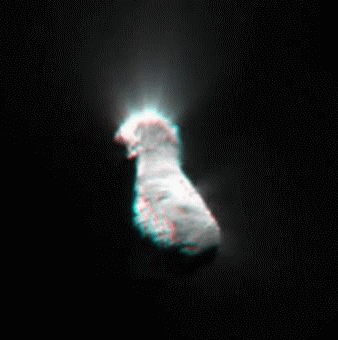
Put on your red/blue glasses and have a good space travel! ;-)
Posted by: AndyG Nov 5 2010, 01:48 PM
18 hours - the centripetal force is tiny.
Andy
Posted by: machi Nov 5 2010, 02:12 PM
Cassioli:
WOW, it looks fantastic even with red/green glasses ![]() .
.
Posted by: jgoldader Nov 5 2010, 02:13 PM
So Borrelly, Itokawa, Hartley, I believe some TNOs, and a number of NEOs all have the appearance of being contact binaries.
I guess the surprise to me is the really low relative velocities at impact. When I thought of accretion events, I always imagined them as being not very efficient, where two things would go splat and a significant portion of the mass would be lost at greater than escape velocity. This could be telling us something important about the timescales for planetesimal growth in the early solar system. If accretion events at low relative velocities were very common, then growth timescales would be comparatively short.
(Alternatively, the contact binaries might be a large portion of the *surviving* planetesimal remnants, the rest having been smashed to bits.)
I've been "out of the business" for about 7 years now, so haven't kept up with any of the dynamics work. Anybody out there have a sense of what's being bandied about these days?
Jeff
(and Machi: We-Are-Not-Worthy!)
Posted by: Phil Stooke Nov 5 2010, 02:14 PM
Re: the discussion about boulders vs clumps etc.
Generally speaking, words like boulder - and sand for that matter - are referring to the size of the particles, not what they are made of. No problem calling these lumps boulders even if they are rather low density.
These pics are fabulous - I hope the approach and departure images will also show the dark limb silhouetted against the coma and jets.
Phil (foiled by the last gas leak, coming home without seeing Discovery launch)
Posted by: centsworth_II Nov 5 2010, 03:06 PM
"Lumps." Now that's something else entirely!
It gives the idea of something which is not separate from the surface. Who knows, that could even be the case!
Sticking with technically correct descriptions when the popular interpretation may be different could be a problem if you are trying to communicate an idea to a mass audience. To me, "clump of fine material" has a totally different feel than "boulder of fine material".
Posted by: centsworth_II Nov 5 2010, 03:13 PM
Comet binaries and asteroid binaries... I wonder if a hybrid, one lobe asteroid-like, the other comet -like will ever be found.
In the case of a comet binary, perhaps it's possible that through sublimation an object could be made fragile enough to break apart, forming a binary from an initially single object.
Posted by: vikingmars Nov 5 2010, 03:33 PM
Contact binaries... Hummmm... Reminds me of the excellent RocheWorld novel, where transfer of material occur oftenly from one lobe to another !
Posted by: AndyG Nov 5 2010, 03:35 PM
^ sublimation is possible - as is, I suppose, fracturing due to gravitational influences, with later low-speed re-accretion. After all, these comets got into the inner system somehow.
Andy
Posted by: Phil Stooke Nov 5 2010, 04:25 PM
We can add to that list of things that look like Hartley 2, the asteroid Toutatis, seen quite well by radar.
Phil
Posted by: Syrinx Nov 5 2010, 05:01 PM
My first thought was it looks like what happens when two snowballs collide head-on at the right velocity. The outer "crust" gets blasted away (ejected) while the inner cores remain connected by a band. The result is two massive lobes connected by a marginally thinner band.
When snowballs don't collide head-on, what happens is the two snow balls severely shear each other and continue on their own ways independently with a smaller main body.
Posted by: cassioli Nov 5 2010, 05:44 PM
Machi, it would be great if you could make the complete movie statring from comet being large just like a bean on the screen...
Any chance?
Or could you explain how you exactly made the stunning movie with Squirlz Morph, so I'll try by myself?
Posted by: machi Nov 5 2010, 07:30 PM
There are some problems with longer animation. Images taken longer time before flyby are overexposed (without details) and time delay between first image in animation and
nearest (in time) image is too big, when same timewarp is used (thus final animation is over 1MB limit). But I will try make another intersteps and I will see what can be done.
Posted by: cassioli Nov 5 2010, 09:42 PM
I read somewhere that these are just medium resolution images, and hi-res images are currently being downloaded!! :shock: More of your pathetic whining?
Posted by: djellison Nov 5 2010, 09:49 PM
Careful. These are all images from the MRI ( medium resolution imager ).
There IS a 'High Resolution Imager' that has 5x the res of the MRI. However, it has a flaw - it is out of focus, and out of focus such that it's actual resolution is only about the same power as the MRI. SOME of that out of focus problems can be backed out using deconvolution - but it's not perfect, it's not great, it's not taking it back to its design resolution.
We MAY have images to come that are a LITTLE better than these, but don't expect miracles.
Posted by: Decepticon Nov 5 2010, 10:38 PM
Is there any links to a repeat of the JPL Coverage of the flyby?
Posted by: djellison Nov 5 2010, 11:07 PM
Go to the Ustream page ( www.ustream.tv/nasajpl2 ) and it's archived below.
Posted by: centsworth_II Nov 6 2010, 12:03 AM
I'm confused. The first two images below are from http://www.jpl.nasa.gov/news/news.cfm?release=2010-373&cid=release_2010-373&msource=10373&tr=y&auid=7313419#4 the third is from http://planetary.org/blog/article/00002763/
The sizes indicated for Hartley vary widely. Which is it?
Edited: to reflect a change in The Planetary Society Blog image which now is in rough agreement with the far left image. The center image is still a problem which is strange since it and the left image are both on the same web page. It looks like that center image should read 0.5km rather than 0.5 miles?
Posted by: machi Nov 6 2010, 12:25 AM
I think that 1.25 miles/2 km is length of longer axis and 1.2 km is medium diameter.
Posted by: SFJCody Nov 6 2010, 12:35 AM
Puts me in mind of a young Amanita
http://etc.usf.edu/clipart/14800/14815/yng_amanita_14815_lg.gif
Posted by: Hungry4info Nov 6 2010, 12:45 AM
Movie of the flyby imagery here, seems to show some images we haven't seen.
http://epoxi.umd.edu/3gallery/vid_20101104_approach.shtml
(requires quicktime)
Posted by: elakdawalla Nov 6 2010, 03:28 AM
The sizes indicated for Hartley vary widely. Which is it?
That is what is known as a "mistake." I'd gotten the Photoshop file ready for inclusion of Hartley 2 before the Arecibo observations, so I didn't have the new diameter, and I forgot to update it in my hurry today. There's a new version of the image now; thanks for pointing out the error.
Posted by: centsworth_II Nov 6 2010, 05:50 AM
Posted by: elakdawalla Nov 6 2010, 05:02 PM
Just be patient. They haven't had time yet to come to agreement on an official new diameter for Hartley 2. They have to get the final navigation solution to be sure of range to the target, figure out what angle they're seeing the long axis at, etc etc. There's no point in them issuing a number that they'll have to correct later. They're using whole- and half-kilometer estimates and then doing low-precision conversions to Imperial units. Just be patient and we'll eventually see an official diameter announced. Consider everything between now and then to be imprecise, plus or minus 50%.
Posted by: siravan Nov 6 2010, 05:09 PM
Returning to the question of the Hartley 2 shape and whether sublimation can cause such a shape, I ran a simple simulation; starting from a spherical shape and solving the sublimation differential equation in time for different rotation axis angles. For alpha=0 (i.e. axis perpendicular to the orbital plane, the arrow points to sun), the object elongates and then develops a waist. For alpha=90, it morphs into a discoid shape. For alpha=30 and 60, the shape looks like a bottle and a bullet, respectively. Of course, this is a very simplified model (starting from a perfect sphere, no shadowing...), but it shows that sublimation is one of the forces shaping a comet shape.
Posted by: ngunn Nov 6 2010, 07:01 PM
Nice work siravan!
Posted by: Daba Nov 6 2010, 09:14 PM
A couple of amazing facts about Hartley 2.
http://scienceblogs.com/startswithabang/
And btw. great, great science blog!
Posted by: nprev Nov 6 2010, 10:11 PM
Boy, no kidding nice work, Siravan! Heck, I'd call it fundamental work! The bowling-pin shape seems much less mysterious now.
Posted by: Paolo Nov 6 2010, 10:25 PM
the only problem that I see with the model is the assumption of starting with a sphere. what would happen with other, more likely shapes?
Posted by: centsworth_II Nov 6 2010, 10:26 PM
http://scienceblogs.com/startswithabang/
From the blog:
"Unlike other comets, with their tails made mostly of ice, melting into water, the tail of Comet Hartley is mostly rocky dust and carbon dioxide....
Because it's not a traditional comet; it's an asteroid that simply got too close to the Sun!"
Really? Is this an accepted interpretation?
Posted by: cassioli Nov 6 2010, 10:29 PM
full inline quote removed - ADMIN
yeah, would any asteroid behave like a comet if "coming too close to the sun"?!? ![]()
Posted by: Paolo Nov 6 2010, 10:30 PM
it's the first time I read this suggestion and to me, it makes no sense. why would other asteroids that venture far closer to the Sun behave like asteroids then?
Posted by: ngunn Nov 6 2010, 10:45 PM
My guess (not involving differential equations) is that the sphere is the initial shape least likely to end up as a bowling pin. The beauty of siravan's result is it shows that even a sphere can do so.
Re the blog post - I have no problem with it. An asteroid that has had a low perihelion for a long time will have finished any comet-like behaviour and be cooked dry. On the other hand one that has more recently been perturbed so as to lower its perihelion might still be comet-like.
Posted by: nprev Nov 6 2010, 11:07 PM
I'm also very dubious about that statement concerning Hartley-2's effluent composition. For one thing, the nucleus is extremely active, and unless it's very, very anomalously enriched in CO2 the bulk of those jets has to consist of water vapor.
Not buying it.
Posted by: ngunn Nov 6 2010, 11:34 PM
I think we'll find plenty of water in the asteroids. (Looking forward to Vesta snd Ceres!) I think that the asteroid belt and the Kuiper belt are parts of a continuum, albeit one that has had a large swathe carved though it by the giant planets making intermediate objects rare.
On the subject of bowling pins (or dumbells) here's another: http://t2.gstatic.com/images?q=tbn:ANd9GcTi6mN2QD812nyQ96Re3M_om6X_Q0Ppl6nq-TTlBpEr5ON02uw&t=1&usg=__xL4KNMtb7bJAYvwBbwQkdYu8MoU=
http://www.google.co.uk/imgres?imgurl=http://www.cfht.hawaii.edu/Science/Astros/Imageofweek/ciw-image/061100.gif&imgrefurl=http://www.cfht.hawaii.edu/Science/Astros/Imageofweek/ciw061100.html&usg=__0AX1uulPYKLNXQDRZtmxgPr3NQE=&h=742&w=826&sz=92&hl=en&start=41&zoom=1&tbnid=q0Z-fBb6nsJcAM:&tbnh=154&tbnw=171&prev=/images%3Fq%3DAsteroid%2BKleopatra%26um%3D1%26hl%3Den%26client%3Dfirefox-a%26sa%3DN%26rls%3Dorg.mozilla:en-GB:official%26biw%3D1280%26bih%3D825%26tbs%3Disch:10%2C1723&um=1&itbs=1&iact=hc&vpx=362&vpy=145&dur=10846&hovh=213&hovw=237&tx=35&ty=239&ei=rOfVTIWrHtS7jAf46LzHCQ&oei=nefVTJrFAYq1hAfP1fTJBQ&esq=3&page=3&ndsp=20&ved=1t:429,r:11,s:41&biw=1280&bih=825
Posted by: siravan Nov 7 2010, 12:05 AM
As ngunn mentioned, the reason I started from a sphere was to show that even in absence of any asymmetry except in rotational axis, it is possible to get a complex shape just as a result of sublimation. I haven't run the simulation for other initial shapes, but my guess is that for a wide range of shapes (reasonably convex and smooth), the final result would be more or less the same.
Now, the case for Hartley 2 is much more complex. If I interpret what A'Hearn said during the press conference correctly, Hartley 2 rotational axis is not aligned with its symmetry axis, rather it is spinning in a complex fashion, probably even chaotic. Also, most of the jets are localized at the two ends rather that in the middle. This is probably because the smooth area is a dust trap and all that dust protects this area from sublimation. The reason that the waist is a dust trap is the complex gravitational potential of such an asymmetrical shape. I have attached a quick surface potential calculation for Hartley 2 (assuming uniform mass distribution); the smooth area is located at the bottom of the gravity well.
Posted by: ngunn Nov 7 2010, 12:28 AM
I think you have here discovered the reason for the ubiquity of 'contact binaries' in the asteroid and Kuiper belts. They don't form by two objects coalescing from a very gentle mutual orbital dance. They form, they must form, by the erosion of larger bodies.
Posted by: ElkGroveDan Nov 7 2010, 12:53 AM
Siravan, quick write a paper. Even a small one. G
Posted by: Phil Stooke Nov 7 2010, 02:00 PM
One comment on Siravan's model: It suggests that the bilobate shape would only exist for a short time late in the object's evolution - for most of the time it's a prolate spheroid. And presumably soon after the object takes that shape it disintegrates entirely. If it only has that shape for (say) 10% of its life it suggests we should only see 10% of objects looking like that. If we see a lot of these objects, another theory might be needed.
Phil
Posted by: AndyG Nov 7 2010, 03:02 PM
One comment on the real world situation: as a body narrows, it's likely to change its spin axis - not continue rotating along its long axis. This would suggest, over time, the trend of continued sublimation on a spherical body would be for it to stay spherical.
I think.
Andy
Posted by: ngunn Nov 7 2010, 03:08 PM
I'm not so sure of that. As shrinkage is driven initially by sublimation, presumably the residue gets progressively more ice-poor until there is negligible sublimation. Subsequent shrinkage would proceed only by the much slower process of micrometeorite erosion. I think a 'dead' comet could survive in dumbell form for a very long time, looking and behaving exactly like some asteroids. Even after the original neck broke the two lobes would just roll together in a new configuration.
Posted by: siravan Nov 7 2010, 03:39 PM
Phil
It was a simplified models. In reality, there are many other factors involved in determining the sublimation rate. For example:
1. When the comet nucleus becomes bilobate, the waist becomes a dust trap which prevents further sublimation from the waist.
2. A bilobate shape is concave and has complex shadowing.
3. A solid and spinning object tends to align its spin axis with the axis of maximum angular inertia, which for an elongated shape is perpendicular to the long axis.
4. Most comets, including Hartley 2, vent both H20 and CO2 (among other things), which of course have different sublimation temperatures.
5. many other factors...
My pure speculation is that a bolibate shape is pseudo-stable, i.e. for a large subset of initial conditions, the comet nucleus reaches a bilobate shape in some point in its evolution and from this point on the net results of all the different factors is to keep in more or less in the same shape.
Posted by: djellison Nov 7 2010, 03:53 PM
Wild 2 and Tempel 1 do not subscribe to this model. What does that say about them, and the model?
Posted by: ElkGroveDan Nov 7 2010, 03:55 PM
I couldn't help but notice that Tempel 1 and Wild 2 do in fact resemble the more oblate shapes in siravan's graphic.
(images shamelessly stolen from the Ted/Emily chart)
Posted by: ngunn Nov 7 2010, 04:10 PM
I checked the perihelia since that is one factor that must have a bearing on sublimation: Wild 1.592, Tempel 1.509, Borelly 1.35, Hartley 1.05, Halley 0.587.
Posted by: siravan Nov 7 2010, 04:12 PM
One possible explanation is that both Wild 2 and Temple 1 have a lower eccentricity orbit compared to the rest. One assumption of the model is that sublimation primarily happens close to perihelion. For a more "circular" orbit, sublimation is more or less yearlong and the model doesn't work.
Posted by: bk_2 Nov 9 2010, 07:31 AM
Except for the peanut case, where the axis is vertical to the plane of orbit, since it will retain the same orientation all the way round.
Posted by: Phil Stooke Nov 9 2010, 02:22 PM
One other point - don't think it's been raised before. The model presumably assumes globally unifiorm sublimation rather than localized active regions. An alternative hypothesis might be that many comets are eroded away at one or more points so deeply that they spontaneously break up into two or a few chunks, which reassemble into bi- or poly-lobate forms with the loose debris falling into the middle region. That could happen several times during the life of a nucleus. Same thing would apply to asteroids disrupted by collision, accounting for the similar forms we see in both populations.
Phil
Posted by: Paolo Nov 9 2010, 08:25 PM
meanwhile, ESA has released an infrared image of Hartley 2 taken by Herschel
http://sci.esa.int/science-e/www/object/index.cfm?fobjectid=47909
Posted by: elakdawalla Nov 9 2010, 08:32 PM
I just made one of my handy-dandy index pages to the Deep Impact Hartley 2 Encounter images:
http://www.planetary.org/data/di/
Posted by: Decepticon Nov 10 2010, 12:00 AM
Strange I read on Space.com that thousands of images where taken.
Is that a error?
Posted by: djellison Nov 10 2010, 12:08 AM
In the entire encounter - from a few months out, and the next few weeks - in total it's more than 100,000
During the close encounter phase, it's certainly hundreds of image. We put the actual imaging sequence into Eyes on the Solar System - you can see it still under the EPOXI Replay http://solarsystem.nasa.gov/eyes/ . None of the images marked AutoNav are downlinked, but all the ones marked science should be. As a point of note - the image names that include 600000something - watch out for those in the top right corner as the replay happens - you will see them appear. That's the 5 'early downlinked' images that we've had released to date.
Posted by: cassioli Nov 10 2010, 08:53 AM
I read that for flyby "199 images were taken".
But these data are meaningless without a time interval!
Posted by: elakdawalla Nov 10 2010, 05:13 PM
Check the http://www.planetary.org/explore/topics/deep_impact/hartley2_timeline.html, you can answer that yourself!
Posted by: Paolo Nov 12 2010, 07:27 AM
Back to EPOCh mission, on arXiv yesterday there was a nice paper resuming all the exoplanets observations
http://arxiv.org/abs/1011.2229
Posted by: cassioli Nov 12 2010, 12:00 PM
and within which two time-steps were the 199 images taken?
Posted by: Phil Stooke Nov 12 2010, 12:57 PM
Yes, that is a good point... but remember that the encounter is still going on and a fantastic dataset has to be looked at to get some early analysis done for upcoming scientific meetings. There's lots to do, and extended missions are always run with limited funds and staff. There's lots of time to get the full details out. It will become clear.
Phil
Posted by: djellison Nov 12 2010, 03:56 PM
You can find out for yourself by using Eyes on the Solar System - you can see every single command for imaging in real time. That should answer any and all questions you have about the frequency, type and number of images taken.
http://solarsystem.nasa.gov/eyes
To my knowledge, there is no more detailed description of the imaging sequence available than that.
Once you've figured it out, please share the results with us.
Posted by: cassioli Nov 12 2010, 08:19 PM
full inline quote removed - ADMIN
Looks like it does not work on my 16:9 monitor, all controls appear garbled, can't see help button, can't understand how to use controls... ![]()
Posted by: djellison Nov 12 2010, 08:25 PM
Change you resolution to something less than 2560 x whatever.
That's a known flaw with the Unity plugin. On 30" or 27" displays. Set your res to 1920 x 1080 / 1200 and you'll be good to go.
Posted by: cassioli Nov 12 2010, 08:29 PM
full inline quote removed - ADMIN
Actually it's a 32" TV set 1360x768.
Posted by: djellison Nov 12 2010, 08:36 PM
![]()
Then try a monitor. A laptop. Something else.
I don't wish to seem rude here - but it does seem like you're essentially refusing to think for yourself.
Your continued full inline quoting also shows you don't take note of UMSF admin either.
My patience is just about expired.
Posted by: Paolo Nov 14 2010, 12:51 PM
one fundamental detail of the Hartley 2 images that I have not been able to find: what is at best the pixel size (I dare not call it "resolution") at closest approach?
Posted by: djellison Nov 14 2010, 01:10 PM
http://epoxi.umd.edu/7press/schedule.shtml
"The MRI pixel scale at closest approach will be 7 m/pixel"
Posted by: Den Nov 15 2010, 02:44 PM
Excellent work! However, this model does not account for the formation of protective dust / regolith layer.
The dusty "waist" has to be a very good insulator inhibiting further sublimation.
To me it still looks like contact binary explanation is more likely.
Posted by: centsworth_II Nov 15 2010, 03:38 PM
My inexpert gut feeling: The longer the shape, the farther apart the end bulbs, the more likely they are connected by a solid waist. It seems to me that in a contact binary the two bulbs would be in contact, much closer together.
Posted by: Hungry4info Nov 15 2010, 11:16 PM
NASA Announces Comet Encounter News Conference
http://www.nasa.gov/home/hqnews/2010/nov/HQ_M10-161_EPOXI_Update.html
Posted by: AndyG Nov 16 2010, 10:12 AM
I'm liking the reasoning, centsworth_II - but for two elliptical chunks perhaps originally separated by earlier sublimation, their speed at re-contact will have to be below the local escape velocity. That's going to be under 5m/s or so in the Hartley case.
At collision speeds as low as this, and with inelastic structures (voided rubble & ices) I could imagine these bumping together, settling and sticking any way on - not neccesarily in a minimum axis/"best gravitationally settled" condition. Later loose dust and fragments would gravitate to the waist to make the observed contact beach.
Andy
Posted by: Paolo Nov 17 2010, 08:39 PM
cryptic message on Twitter and Facebook about tomorrow's press briefing:
I guess they will be presenting HRI images...
Posted by: djellison Nov 17 2010, 09:37 PM
Not cryptic... they used a green plastic drinks bottle during the first press conf to show the orientation of the comet etc.
Posted by: elakdawalla Nov 17 2010, 09:45 PM
It seemed like about 75% of the AP photographer's shutter clicks during the press briefing were while Mike A'Hearn was holding up that bottle. Has anybody seen any of those pics -- did any of those photos make it onto the Internet anywhere?
Posted by: stevesliva Nov 17 2010, 11:06 PM
http://www.csmonitor.com/var/ezflow_site/storage/images/media/images/1104-ahearn-comet-encounter.jpg/8979447-1-eng-US/1104-AHEARN-COMET-ENCOUNTER.JPG_full_600.jpg from here:
http://www.csmonitor.com/Science/2010/1104/Comet-Hartley-2-flyby-yields-stunning-photos-of-a-cosmic-oddball
Posted by: hendric Nov 18 2010, 12:26 AM
Fill that bottle with some diet coke and Mentos, then poke holes to demonstrate jets!
(I was thinking for a second, what, they brought LIPOVITAN-D?)
Posted by: tedstryk Nov 18 2010, 06:12 PM
So apparently Deep Impact imaged "snowballs"!
Posted by: Paolo Nov 18 2010, 06:28 PM
fantastic HRI images!
I can't help but pray that Rosetta will not have to deal with "snowballs" like these!
Posted by: elakdawalla Nov 18 2010, 06:53 PM
Is anybody else having trouble making the anaglyph they released today pop into 3D? I find the circles just refuse to overlap, they stay stubbornly non-overlapping no matter how close or far I bring my face to the screen.
Posted by: centsworth_II Nov 18 2010, 06:59 PM
Besides the halo of fluffy snowballs, a big surprise was the large amount of water vapor escaping from the waist contrasted with large amounts of CO2 from the ends. To me, this fits in with the idea of single, solid object being narrowed at the center by differential wasting. Especially if the lack of CO2 from the waist is due to its already having been removed in past passages around the sun. Of course this is a totally inexpert opinion.
http://www.nasa.gov/mission_pages/epoxi/gallery-index.html
Posted by: belleraphon1 Nov 18 2010, 07:41 PM
I could not make the anaglyph they released on the TV today pop into 3D. Had to wait for the webpage release. NOW it pops out.
http://epoxi.umd.edu/3gallery/20101118_Schultz5.shtml
Craig
Posted by: Explorer1 Nov 18 2010, 09:26 PM
Impressive images!
But I doubt Rosetta will have trouble during their landing, these snowballs seem quite benign from what Emily wrote on the blog, plus we don't know yet how active C-G will be in 2014 either.
I'm sure they'll have an extended observing campaign once in orbit to find a perfect landing spot, as Hayabusa did.
Posted by: cassioli Nov 19 2010, 07:38 AM
Yesterday I saw an image containing THREE circles per each ice particle: red, blue... and white! Impossibile to view!
New one does work... but I can only see popping circles, not popping "snowflakes": it would be much better if they posted the two original images, or an additional anaglyph without circles, IMHO.
Posted by: nprev Nov 19 2010, 11:05 AM
I expressed a LOT of skepticism about the CO2 enrichment as stated in early reports...time to eat those words (nom nom nom...burp!) ![]()
And snowballs to boot.
Always the utterly unexpected...I should get used to it by now. Can't wait to see the hypotheses to come!
Posted by: ynyralmaen Nov 19 2010, 09:48 PM
If it does, one good thing is that it won't be a fast flyby; as it'll be moving with the nucleus, the relative speed will be tiny compared to the 12.3 km/s relative speed of EPOXI, so the kinetic energy of each impact will be way lower. Giotto, by the way, endured dust impacts at 68.4 km/s at Halley.
Posted by: centsworth_II Nov 19 2010, 10:10 PM
After seeing the snow storm surrounding Hartley 2, I was glad to see this in http://www.springerlink.com/content/yp57q2325066674v/fulltext.pdf regarding Rosetta:
"10. Front Door Mechanism
The Front Door Mechanism, FDM, is primarily designed to protect the optical components inside the NAC and theWAC by reclosable front doors.... "
Posted by: Phil Stooke Nov 19 2010, 10:49 PM
Let's get Rosetta to rendezvous with some of those snowballs! (just kidding... but imagine some of these things collide, accrete and grow into a moon... )
Phil
Posted by: Hungry4info Nov 19 2010, 10:56 PM
From what I made out at the recent conference, the evaporation of these snowballs is what comprised the majority of water in the coma.
As such, I would suspect that the formation of moons via agglomeration of these would not be very stable over the long term. If the comet is close enough to liberate enough of the 'snowballs' to form metre+ sized moons, then it may be close enough for these 'snowballs' to evaporate.
Which is not to say I've done the math or run simulations.
Posted by: centsworth_II Nov 19 2010, 11:16 PM
Hopefully without Rosetta as the nucleus of such snowballing!
Posted by: centsworth_II Nov 19 2010, 11:28 PM
Is it the evaporation of the snowballs that comprises most of the water or the snowballs themselves? If talking only about water vapor (evaporation), the water vapor image in my post #257 shows a lot of water vapor coming directly off the comet's waist.
Posted by: centsworth_II Nov 20 2010, 09:48 AM
I'm guessing that all H2O and CO2 vapor is permanently lost to space. The H2O more rapidly due to its light weight. But I wonder how much of the dust and snow may make it back to the surface vs how much is lost because it either evaporates or exceeds escape velocity. It must be REALLY complicated to figure out the fate of all the various particles and clumps in such an active environment!
Posted by: djellison Nov 21 2010, 02:07 AM
For those wondering about Rosetta... remember, Deep Imapct flew past Hartley 2 at 12km/sec.
Rosetta will be rendezvousing with C-G, i.e. close to ZERO km/sec - it's just the speed imparted by the out gassing process that will be troublesome
Posted by: brellis Nov 21 2010, 02:25 AM
Sounds like Rosetta needs a bicycle helmet to protect against low-speed impacts ![]()
Posted by: nprev Nov 21 2010, 02:41 AM
I wonder what brave putative PI will someday propose a mission to catch & return snowballs from a comet...? ![]()
Posted by: fredk Nov 22 2010, 03:53 PM
Then you'd have to explain why just the ends, when the "waist" should be the gravitational potential minimum...
Posted by: centsworth_II Nov 23 2010, 08:42 AM
I don't really think that any visible lumps on the surface are fallen snowballs. If I were to guess, maybe as the comet shrinks its dessicated surface breaks up into the clumps we see on the ends. I envision the "boulders" to be composed of freeze-dried masses of dust and organics. Maybe similar in texture to "astronaut ice cream". ![]()
Posted by: vjkane Nov 23 2010, 09:01 PM
Already proposed, in a fashion, by the comet coma rendezvous sample return mission (summary http://futureplanets.blogspot.com/2009/09/comet-coma-rendezvous-sample-return.html and in detail http://www.lpi.usra.edu/decadal/sbag/topical_wp/ScottASandford.pdf ). This mission proposed to return warm samples, though.
The challenge is to know which comets spit snowballs as opposed to just gently outgasing. If Rosetta finds good evidence for snowballs, I expect proposals to follow up with a sample return that doesn't require landing will be made.
Of course, the challenge is to keep those ices cold. The Enceladus sample return analysis from the Decadal Survey (brief as it was) didn't raise keeping temperatures below 0 C as a major issue.
Posted by: nprev Nov 23 2010, 10:16 PM
Yeah, I was thinking that too, and I really don't see any way to do it other than via in situ examination. The only way around that might be to figure out a sample acquisition method that could cope with either chunks or dust with equal effectiveness, but nothing springs to mind.
The cryo storage problem might not be too bad; a Dewar flask of some sort might be enough for the flight hardware, but obviously post-landing recovery would have to be pretty expeditious and include a cold-storage facility.
Posted by: vjkane Nov 24 2010, 12:37 AM
From the Enceladus Decadal Survey sample return mission concept study: "A desire for science benefit is to maintain the sample below 250 K at all times (to keep water below freezing), and it is expected that this could be achieved passively through the orientation of the Earth Return Vehicle (ERV) in the anti-sun direction during cruise, along with use of phase change material surrounding the sample to withstand re-entry heating until the sample is recovered. Also, qualification of aerogel would be required for the collection of larger particles at lower velocities than Stardust, along with preservation of ice in the collection event." p13
So keeping the sample moderately cool (in terms of cometary volatiles; some would evaporate at 250 K), doesn't appear to be the big problem. For the Enceladus concept, the big problem was ensuring planetary protection so any Enceladian life forms don't get loose here on Earth. I don't know if that would be considered a problem for a comet sample return; never have heard it brought up.
Posted by: Phil Stooke Nov 24 2010, 04:36 AM
Earth-based radar might let us see which comets are surrounded by "snowballs" - not resolving them of course but revealing a diffuse target around the nucleus.
Phil
Posted by: nprev Nov 24 2010, 06:43 AM
Interesting thought. It would have to be a very close approach to Earth by a target comet, though, and I wonder if anyone has any idea what the dielectric constant might be for a "typical" (is there such a thing?) comet nucleus, to say nothing of fluffy stuff like a snowball halo?
Definitely worth trying by Arecibo if there's ever an opportunity.
Posted by: djellison Nov 24 2010, 06:57 AM
They did use Arecibo with Hartley 2. It'll be interesting to see, if with the benefit of hindsight, they can say 'Yup - we saw the golf balls'
Posted by: nprev Nov 24 2010, 07:15 AM
Argh...I forgot that! Thanks, Doug.
Looks like it didn't penetrate the 'regolith' as much as I would have thought; good solid skin painting. Sure hope that they take a hard look now for any scattering around the nucleus. Could tell us something about the composition of the balls if they get any sort of returns since the radar frequency is constant.
Posted by: centsworth_II Nov 24 2010, 03:28 PM
Are there any better Hartley radar images than this? It doesn't look like the snow storm rises above the noise.
http://spacespin.org/article.php/101070-arecibo-comet-hartley-2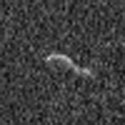
On the other hand, decreasing the brightness leaves a few suspicious spots. I guess it will take some statistical work to determine the chances that those spots represent something real as opposed to random noise.
Posted by: AndyG Nov 24 2010, 03:47 PM
The thing is, these snowballs have been described as "fluffy aggregates of very small particles of ice, like a dandelion puff" and up to basketball size - which must mean most are smaller than the wavelength of a typical radar signal.
I suspect Arecibo stood no chance spotting these.
Andy
Posted by: djellison Nov 24 2010, 04:03 PM
Oh - I don't for one second think we're going to 'see' them in those visualizations of the radar return for the Nucleus. If there's anything present, it'll be in the signal in some other way.
Posted by: ynyralmaen Nov 24 2010, 05:06 PM
Snowballs like this have been detected by radar before, e.g. Hyakutake, as reported in http://www.sciencemag.org/content/278/5345/1921.abstract?sid=384733ca-9f18-4747-82db-97407394d25c. A trail of these objects were also observed from Earth, including by amateurs, as an anti-sunward "spike"; larger telescopes resolved mini-comae surrounding 1-10m-sized "snowballs", as reported http://www.sciencedirect.com/science?_ob=ArticleURL&_udi=B6WGF-45FC19C-6W&_user=125795&_coverDate=03%2F31%2F2000&_rdoc=14&_fmt=high&_orig=browse&_origin=browse&_zone=rslt_list_item&_srch=doc-info%28%23toc%236821%232000%23998559998%23295375%23FLP%23display%23Volume%29&_cdi=6821&_sort=d&_docanchor=&_ct=18&_acct=C000010182&_version=1&_urlVersion=0&_userid=125795&md5=910961128b028cd2cab751fa81ee221a&searchtype=a.
Posted by: cotopaxi Nov 26 2010, 08:49 AM
The required temperature depends on the objective, though. While only a small fraction of H2O will arrive on Earth in gaseous form at 200 or 250 K, the structure of the sample may have changed completely. This is because the equilibrium between sublimation and condensation is maintained, and at a temperature as low as 150 K most of the ice will have sublimated and recondensed at least once during a 5 year cruise. When studying a comet nucleus sample return for ESA's first cosmic vision call, we estimated that a temperature of 135 K would be needed to keep the sample unmodified (assuming that water ice and dust dominate the microscopic structure).
That does not mean to say that a sample return at higher temperatures would not be valuable, of course. And for the "snowflake collection" a higher temperature could be reasonable I guess because at the time of collection the sample will be relatively warm anyway.
Posted by: Paolo Jan 4 2011, 08:39 PM
I was reading an article about H2 in an Italian popular astronomy magazine. it mentions as a possible origin for the nucleus' smooth surface tidal interactions with Jupiter during the April 1971 flyby at 0.09 AU.
Anyone heard of a similar theory? My impression is that the distance is too large for it to tear apart and re-aggregate even a loosely-bound "rubble pile", but maybe I am wrong.
Posted by: Gsnorgathon Jan 5 2011, 09:13 AM
.09 AU would put it ~7 times farther out than Callisto. I dunno nuthin' 'bout no gravity, but that seems awfully far to do any sort of resurfacing.
Posted by: Phil Stooke Jan 5 2011, 02:02 PM
Agreed. The idea isn't bad but I might be looking for an earlier and much closer encounter if orbit data are good enough - might be too chaotic, though.
Phil
Posted by: Paolo Feb 18 2011, 06:00 AM
there is a new article on EPOXI's "Earth as an alien planet" observations on arXiv today
http://arxiv.org/abs/1102.3625
Posted by: Juramike Feb 18 2011, 02:46 PM
Very cool. Thanks for that link!
Posted by: Paolo Mar 11 2011, 07:59 PM
I noticed this paper on Astronomy & Astrophysics http://www.aanda.org/index.php?option=com_article&access=standard&Itemid=129&url=/articles/aa/abs/2011/04/aa16060-10/aa16060-10.html (in free access at this moment)
It seems comet Tuttle has yet another dumbbell-shaped nucleus:
Posted by: Paolo Jun 16 2011, 06:30 PM
I was expecting tomorrow's "Science" to include articles on early MESSENGER science and instead: http://www.sciencemag.org/content/332/6036/1396
Posted by: Phil Stooke Jun 17 2011, 04:37 PM
A nice summary, but don't panic, folks, there's no new map of the nucleus yet! Interesting description of the rotation state though - a long axis mode like those of Halley, Toutatis and maybe Hyperion.
Phil
Posted by: ugordan Jul 4 2011, 06:14 PM
Looks like the Rosetta Steins data wasn't the only one to hit the Small Bodies node recently. Here's Hartley 2 in natural color, OGB filters overlaid over a slightly better quality (closer and less smeared) clear frame. A bit of gapfill was used from that low res OGB data at the right limb where deconvolution ringing was caused by proximity to the image edge. Magnified 1.5x from the original pixel scale.
There's this and the outbound color shot, but it's badly smeared. The rest of the HRI frames appear to be clear frames only...
Posted by: Phil Stooke Jul 4 2011, 06:55 PM
Very nice! Thanks.
Phil
Posted by: Decepticon Jul 5 2011, 12:47 AM
ugordan - Amazing work!
Posted by: machi Jul 14 2011, 06:22 PM
Comet Hartley 2 from High Resolution Imager. Color data are similar to the Ugordan's image of Hartley. Only difference is, that I used red filter and not orange one.
I was focusing more on nucleus, so I used higher resolution underlaying image and jets are somewhat suppressed (and processed with different type of deconvolution).
Image has original size with resolution 4.5 m/pix (original resolution of color images is around 15 m/pix).
Posted by: ugordan Jul 14 2011, 06:50 PM
Nice! I used "orange" because being centered at 650 nm it is in actuality red, whilst the "red" filter is centered around 750 nm so is in fact near-infrared.
Posted by: machi Jul 14 2011, 07:01 PM
Thanks!
So this is result, when one looks more on filter names and not on nanometers. ![]()
Posted by: ugordan Jul 14 2011, 07:14 PM
Even though that name is a bit clumsy, I actually quite like the way they chose HRI imager filters, a simple and straightforward approach. Pretty much each filter has a bandpass of 100 nm, sharp cutoff and neighbors nicely with the next filter and the wavelengths are easy to remember. If it wasn't for the defocus problem, it would have been one sweet instrument.
Powered by Invision Power Board (http://www.invisionboard.com)
© Invision Power Services (http://www.invisionpower.com)
